-
[This season's strongest cold wave] Heavy snow mainly on the Sea of ??Japan side, beware of blizzard, traffic problems also
2026/01/11 08:12

-
The area around Japan will experience a strong winter-like atmospheric pressure pattern from today, the 11th (Sunday) to the 12th (Monday), and strong cold air will flow into the sky.
As a result of this, it is expected that there will be severe storms,
heavy snowfall, and heavy snowfall over a wide area from western Japan to northern Japan until the 12th (Sunday).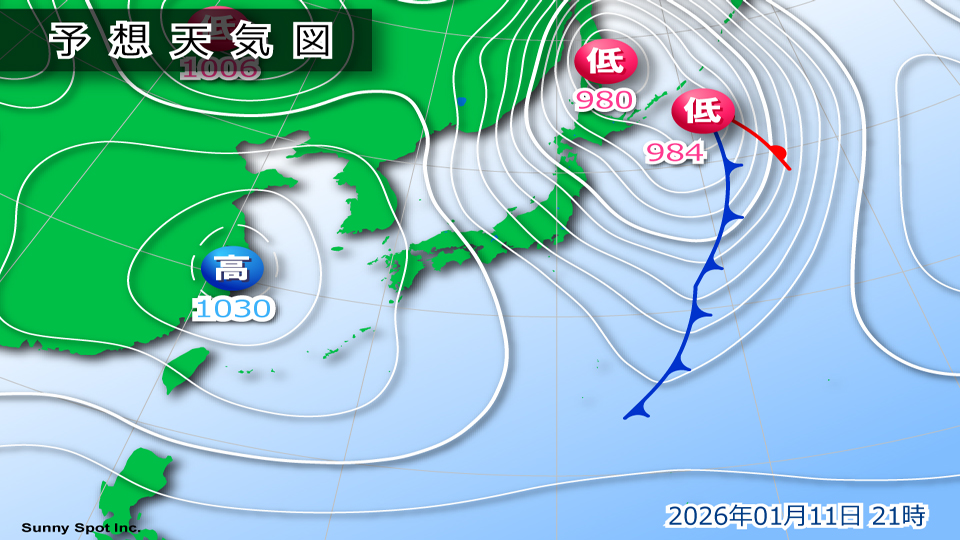
Extreme vigilance is required for strong winds, heavy snowfall, and high waves from the 12th (Sunday) mainly on the Sea of Japan side of northern Japan to western Japan. Also, be wary of traffic problems caused by heavy snow, blizzards, and snowdrifts, and avoid making unnecessary movements.
There is a risk of snow accumulation even in the flatlands of western Japan, where it usually does not snow.
Extreme vigilance is required.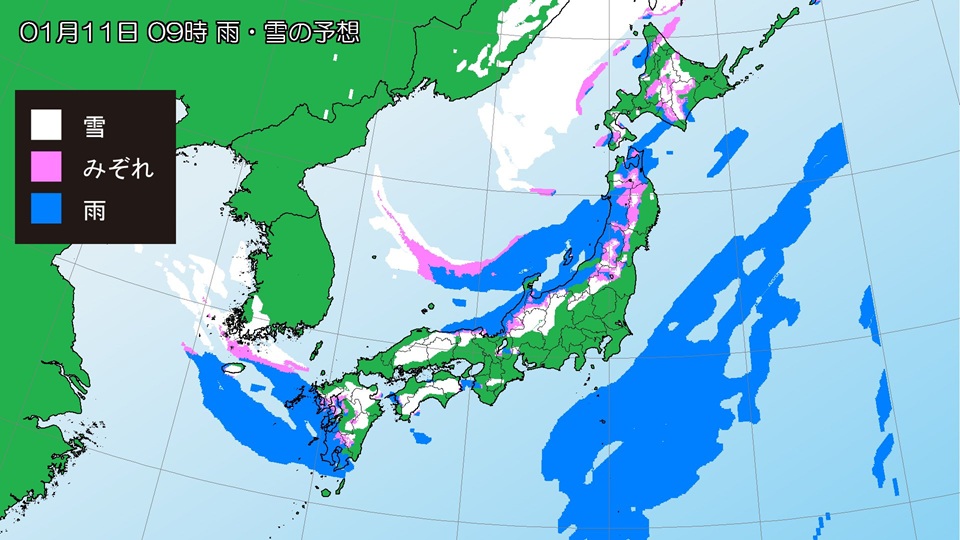

[Snow forecast]
There will be heavy snow in some places from northern Japan to western Japan from the 12th.
The expected amount of snowfall in the 24-hour period from 6:00 on the 11th to 6:00 on the 12th is high in some places.
+Hokkaido region 50 cm
+Tohoku region 80 cm
+Kanto-Koshin region 50 cm
+Hokuriku region 80cm
+Tokai region 80cm
+Kinki region 60cm
+Chugoku region 50cm
+Shikoku region 25cm
+Northern Kyushu region 20 cm
Then, the expected 24-hour snowfall from 6:00 on the 12th to 6:00 on the 13th is expected to be as follows:
+Hokkaido region 30 cm
+Tohoku region 40 cm
+Hokuriku region 30cm
[Wind Forecast]
Very strong winds will blow from the Japan Sea side of western Japan to eastern Japan on the 11th, and on the Japan Sea side of northern Japan until the 12th.
Maximum wind speed (maximum instantaneous wind speed) expected on the 11th
+Hokkaido region 25 meters (35 meters)
+Tohoku region 20 meters (30 meters)
+Kanto-Koshin region 23 meters (35 meters)
+Hokuriku region 23 meters (35 meters)
+Kinki region 23 meters (35 meters)
+Chugoku region 23 meters (35 meters)
+Northern Kyushu region 20 meters (30 meters)
Maximum wind speed expected on the 12th (maximum instantaneous wind speed )
+Hokkaido region 23 meters (35 meters)
+Tohoku region 20 meters (30 meters)
+Hokuriku region 20 meters (30 meters)
-
[The coldest weather this winter] Be wary of heavy snow and blizzard during the second half of the holidays; transportation may be affected; weather for the week
2026/01/10 12:09
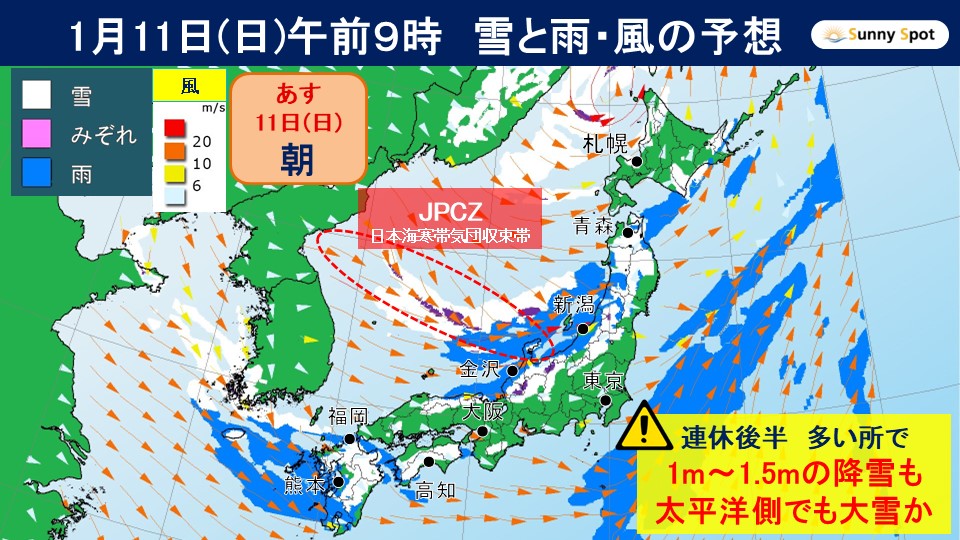
-
#Weather points for the next week#
+The second half of the holidays, the most intense cold air this winter has flown in
+On the Sea of Japan side, warning-level heavy snow and blizzard
+After the holidays, the winter-like pressure pattern becomes stronger again
+Temperatures will rise and fall over the next week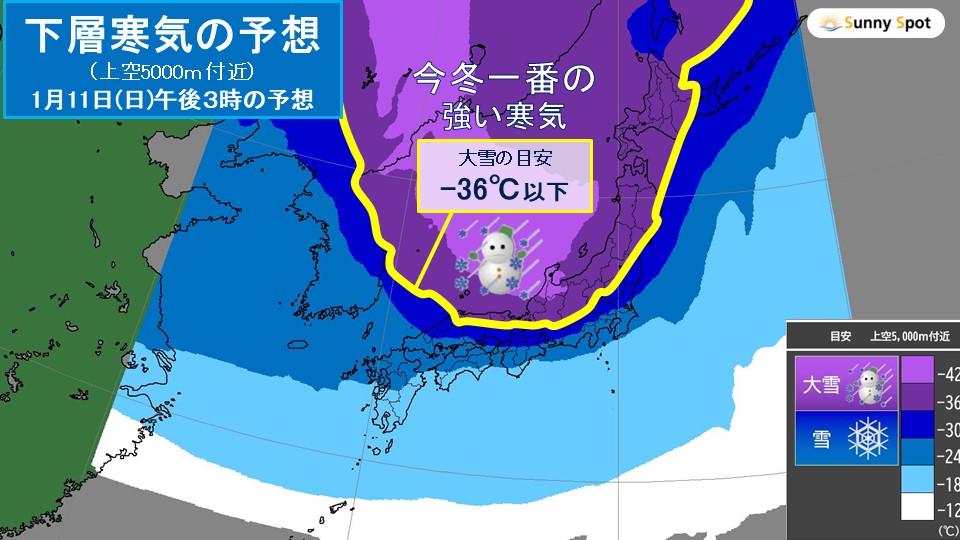
The strongest cold air of this winter is expected to reach -42 degrees or below around 5000m above northern Japan and the Hokuriku region from tomorrow the 11th (Sunday) to the 12th (Holiday) on Coming of Age Day.
In addition, the winter-like atmospheric pressure pattern will become stronger,
leading to extremely stormy weather mainly on the Sea of Japan side.
Nearly 1m to 1.5m of snow will fall in the second half of the holiday alone, and the snowfall will increase rapidly.
Furthermore, there is a risk of a blizzard accompanied by strong winds.
Snow clouds and rain clouds will temporarily flow in on the Pacific side as well.
There will be places where it will snow and rain.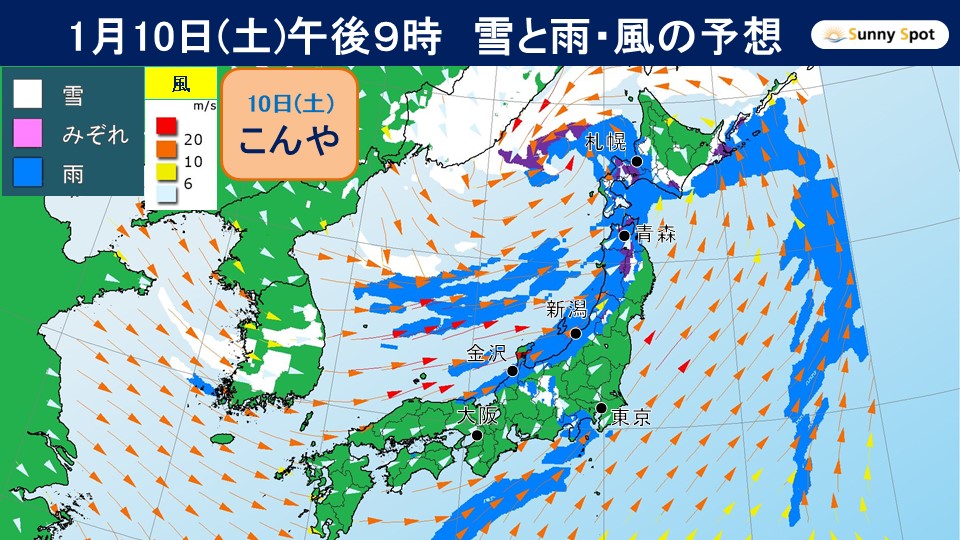
Forecast for snow, rain, and wind tonight.
Rain and snow clouds are expected to cover parts of the Sea of Japan side of northern Japan, Hokuriku, and the Pacific side of eastern Japan.
Today, due to the influence of warm air heading toward a low pressure system, it looks like there will be many places in northern Japan where it will rain instead of snow.
However, the wind has become stronger from today,
Maximum wind speed (maximum instantaneous wind speed) expected from today 10th (Sat) to 11th (Sun)
Hokkaido region 20 meters (30 meters)
Hokuriku region 23 meters (35 meters)
Chugoku region 23 meters (35 meters)
Northern Kyushu region 20 meters (30 meters)
.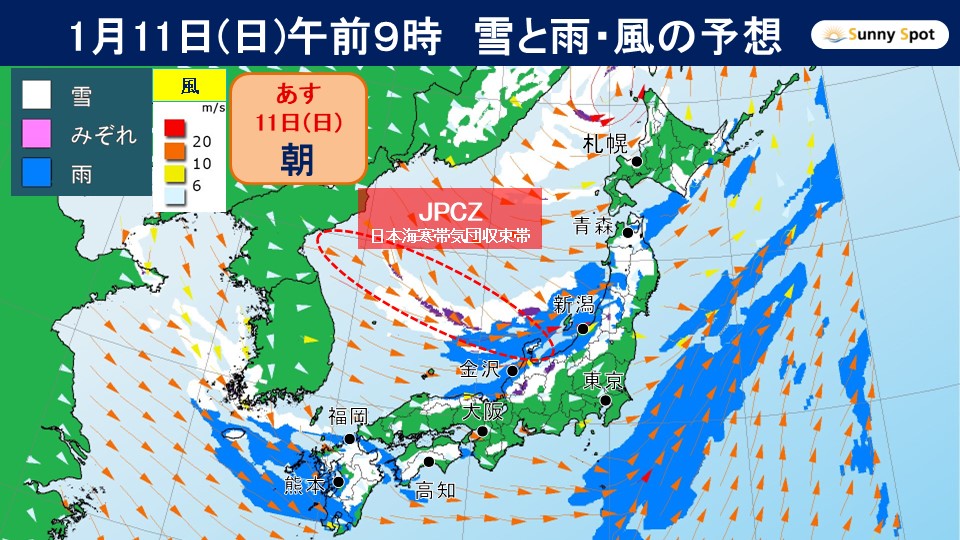
On the 11th (Sunday) tomorrow, a JPCZ (Japan Sea Polar Air Mass Convergence Zone) is expected to form in the Sea of Japan and move toward the Hokuriku region.
JPCZ is a convergence zone created when
cold air currents (northern winds) are divided into two by a high mountain in the northern part of the Korean Peninsula,
and then merge again over the Sea of Japan.
A band of active snow clouds and rain clouds will occur near the convergence zone, and
there is a risk that the amount of snow and rain will increase in areas where this band covers.
A wide range of areas along the Sea of Japan, including Hokuriku and Tohoku, need to be on guard against heavy snow.
In addition, strong winds will bring snow clouds to Kyushu and Shikoku, and
it is likely that snow will accumulate in some places even in flat areas.
It will snow in areas where it doesn't usually snow.
In areas where snow is expected, avoid driving a vehicle without winter tires.
Tomorrow, the 11th (Sunday), is expected to be the peak of snow and wind over a wide area.
Transportation may be affected, so please pay attention to the latest weather and traffic information when traveling during the
holidays.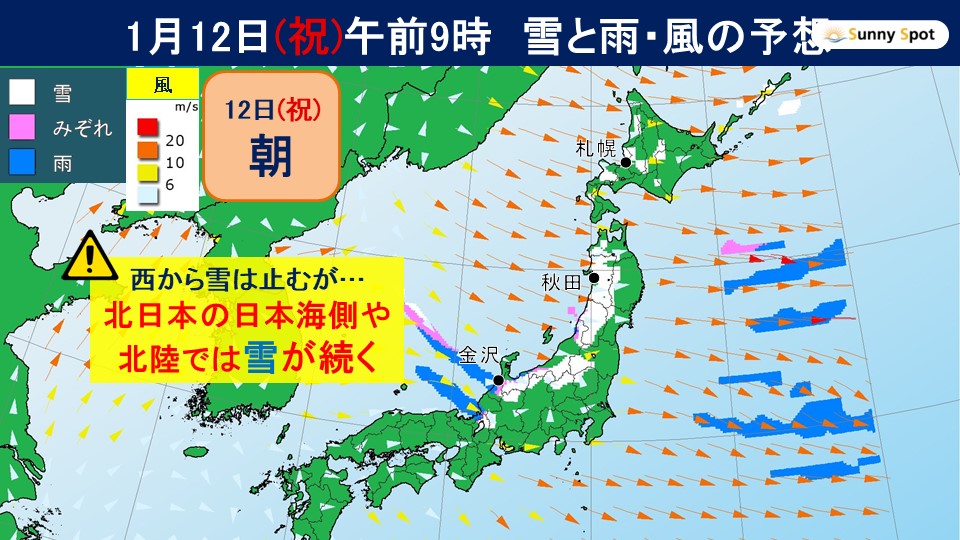
On the 12th (Monday/holiday), the last day of the long weekend, high pressure will extend from the west, and snow will stop in many places from western Japan.
However, strong winds are still blowing in northern Japan, so vigilance against storms is still necessary.
Maximum wind speed (maximum instantaneous wind speed) expected on the 12th tomorrow (Monday/holiday)
Hokkaido region 20 meters (35 meters)
Tohoku region 23 meters (35 meters)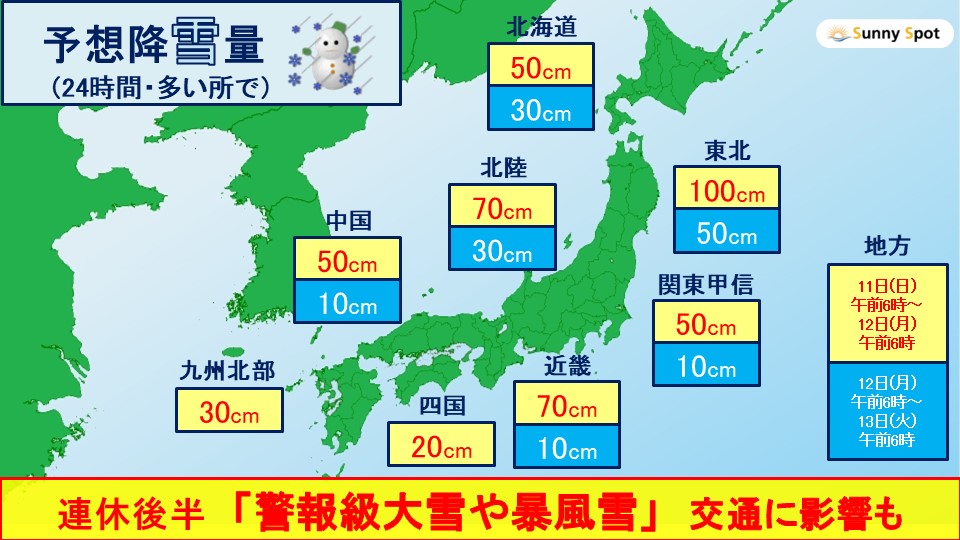
The expected 24-hour snowfall during the holidays is expected to be 50 cm
from 6 a.m. tomorrow the 11th (Sunday) to 6 a.m. the 12th (Monday/holiday)
Hokkaido region 50 cm
Tohoku region 100cm
Kanto-Koshin region 50cm
Hokuriku region 70cm
Kinki region 70cm
Chugoku region 50cm
r Shikoku region 20 cm
Northern Kyushu region 30 cm
12th (Monday/holiday) 6:00 a.m. to 13th (Tuesday) 6:00 a.m.
Hokkaido region 30 cm
Tohoku region Directions: 50 cm
, Kanto-Koshin region, 10 cm
, Hokuriku region, 30 cm
, Kinki region, 10 cm
, Chugoku region, 10 cm
.
From now on, the temperature is likely to change drastically from day to day, with strong cold air flowing in and out.
The temperature difference will be large, so please be careful not to get sick.
Also, the air on the Pacific side continues to be dry, so
please be careful when handling fire.
-
El Nino Monitoring News: La Nina-like conditions are rapidly dissolving, and normal conditions are expected to continue in spring
2026/01/10 07:53
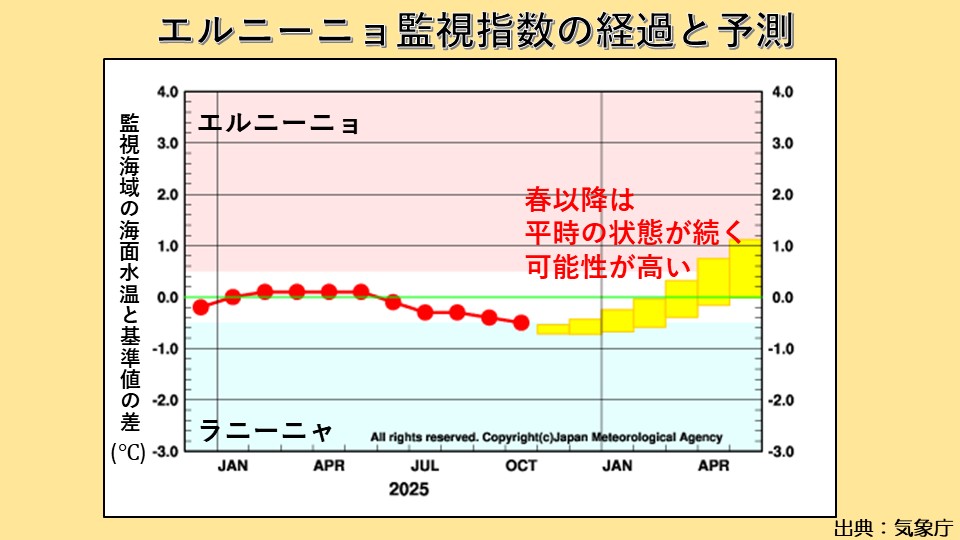
-
On the 9th (Friday), the Japan Meteorological Agency announced the latest El Nino monitoring bulletin.
Currently, the situation appears to be normal, with neither El Nino nor La Nina occurring, but conditions are close to La Nina. This situation is expected to rapidly resolve towards the end of winter.
The difference in sea surface temperature in the El Nino monitoring area in December from the standard value was -0.6c, which was lower than the standard value. Additionally, the five-month moving average used to determine the occurrence of El Nino and La Nina phenomena in October was -0.5 C, close to the standard value.
Sea surface temperatures in the equatorial Pacific Ocean remained higher than normal in the western region and lower than normal in the eastern region. The easterly winds (trade winds) in the lower atmosphere of the equatorial Pacific region were slightly stronger than normal throughout the region, and convective activity became inactive near the international date line in the equatorial Pacific region.
From the above, although it is a normal state where neither El Nino nor La Nina phenomena have occurred, the situation is close to that of La Nina.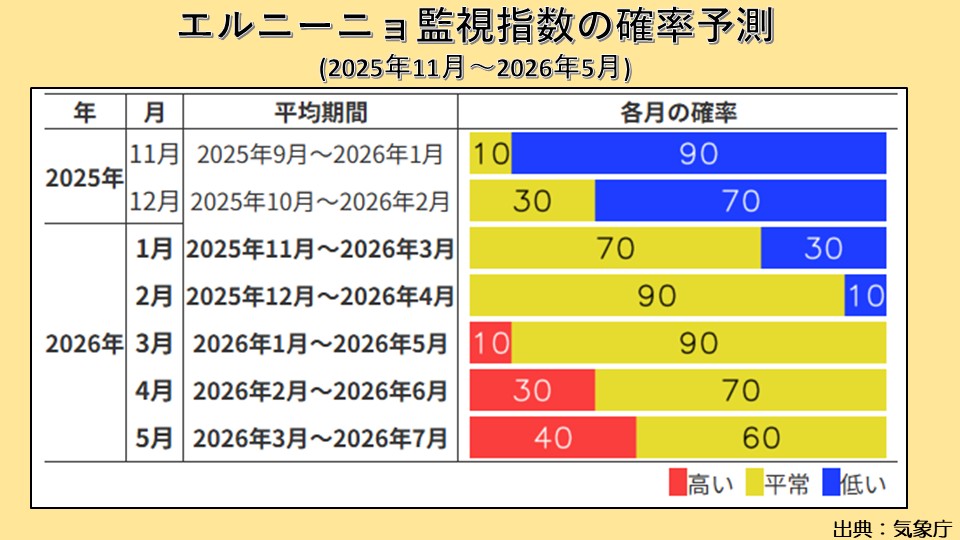
According to the live report, warm water on the surface of the ocean from the western part of the equatorial Pacific Ocean to around the international date line is moving eastward. For this reason, the integrated atmosphere-ocean model predicts that sea surface temperatures in the El Nino monitoring area will rise as the warm water moves eastward, reaching a value close to the standard value by the end of winter. Furthermore, towards the end of spring, the value will remain close to or higher than the standard value.
From the above, the La Nina-like conditions are expected to rapidly resolve towards the end of winter, and normal conditions will continue into spring.
#What is the El Nino/La Nina phenomenon
The El Nino phenomenon is a phenomenon in which sea surface temperatures are higher than normal from the equatorial Pacific Ocean near the international date line to the coast of South America, and this condition continues for about a year.
On the other hand, a phenomenon in which sea surface temperatures continue to be lower than normal in the same area is called a La Nina phenomenon.
Once an El Nino or La Nina phenomenon occurs, it is thought that abnormal weather will occur all over the world, including Japan.
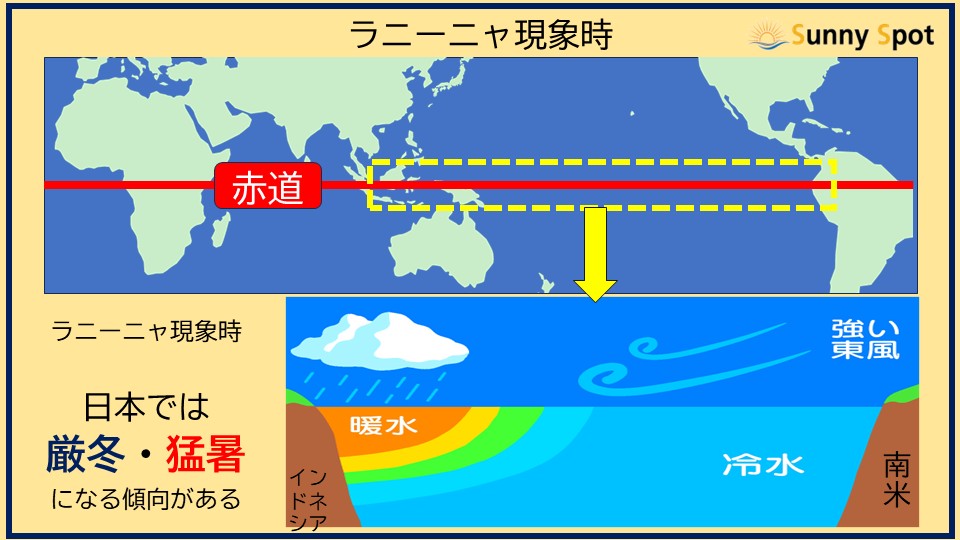
-
Winter storms have arrived - Be wary of heavy snow and blizzards especially along the Sea of Japan during the three-day weekend
2026/01/10 07:46

-
Today, the 10th (Saturday), a low pressure system is rapidly developing as it moves through the Sea of Japan. On the 11th, the middle day of the three-day holiday, a winter-like atmospheric pressure pattern will strengthen as extremely cold air moves southward in the sky, and there is a risk of heavy snow and blizzards mainly on the Sea of Japan side from tomorrow until the 12th (Monday).
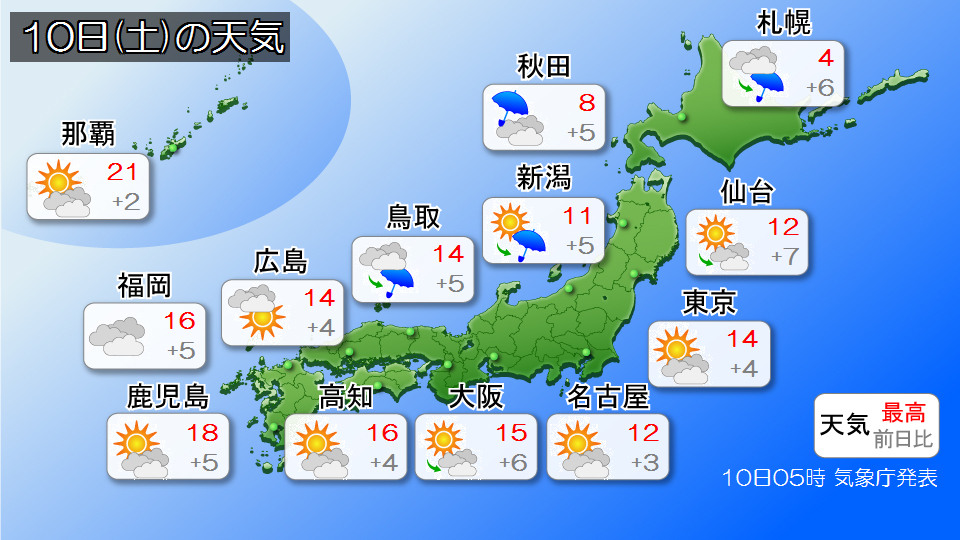
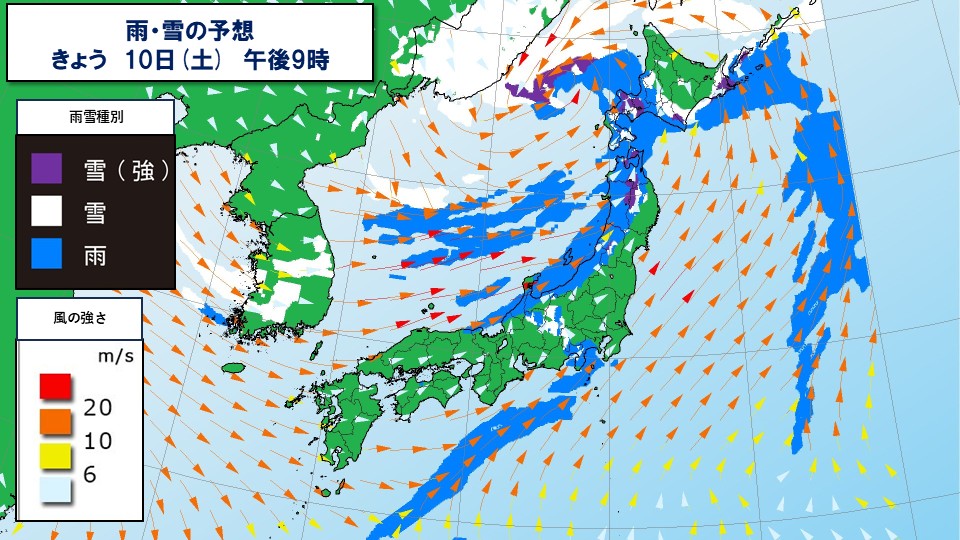
Today, the 10th (Saturday), the weather will be downhill from northern Japan to western Japan on the Sea of Japan side due to the influence of a low pressure front. It will gradually start to rain in the afternoon, and there may be some places on the Sea of Japan side of northern Japan that will experience wet snow. Please be careful of thunderstorms and gusts of wind, such as tornadoes, as they may be accompanied by lightning. On the Pacific side of eastern Japan, it is likely to rain in some places tonight, including the Kanto coast and the Izu Islands.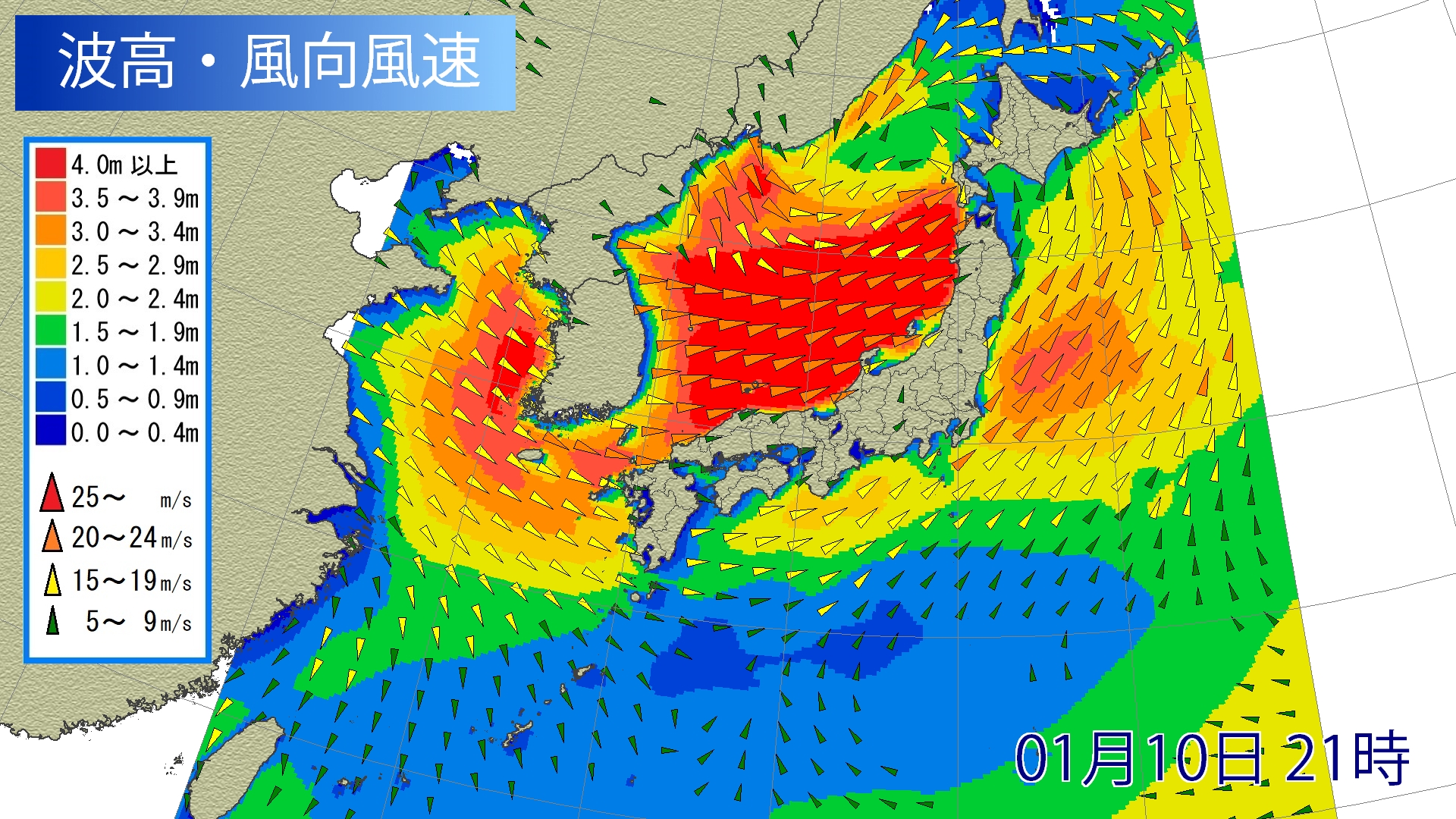
Also, on the Sea of Japan side, the isobars are narrowly spaced, and there will be places where very strong winds blow from the west. The maximum wind speed is expected to reach 23 meters at strong points, and the maximum instantaneous wind speed is expected to reach 35 meters. At sea, the wave height will be over 6 meters. Please be careful of strong winds and high waves.
Western and southwesterly winds will be strong in both western Japan and eastern Japan on the Pacific side, so please be careful of strong winds and high waves in coastal areas.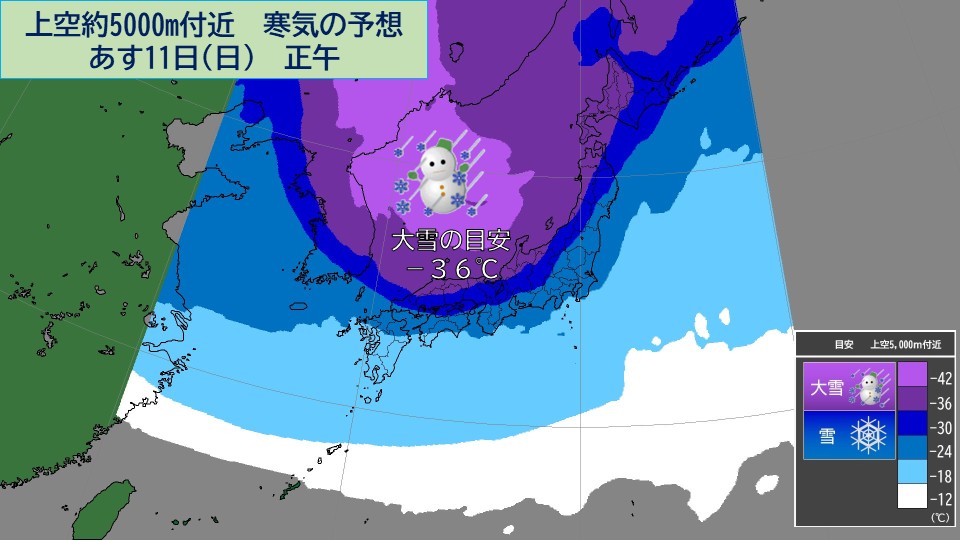
Tomorrow, the 11th (Saturday), extremely strong cold air with temperatures below -36c at an altitude of about 5000m, which is an indicator of heavy snow, will move south toward Honshu. A strong winter-like pressure pattern will form near Honshu, with narrow isobars, and extremely strong winds will continue to blow on the Sea of Japan side. There is a risk of heavy snow and blizzard, mainly on the Sea of Japan side.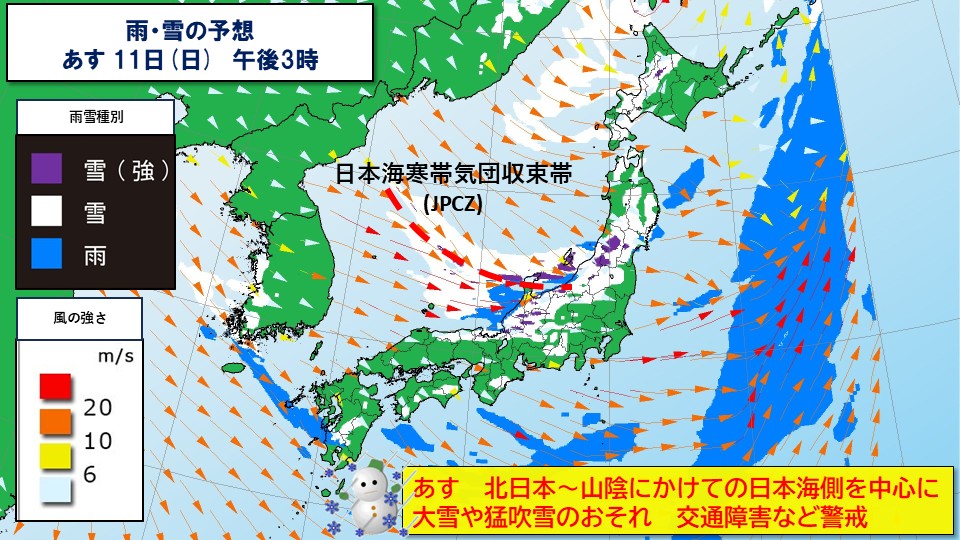
Looking at the snow forecast for tomorrow, the 11th (Sunday), band-shaped snow clouds are expected to develop in an area called the Japan Sea Polar Air Mass Convergence Zone (JPCZ), where northwesterly winds and westward winds collide. Snow clouds are moving into the Tohoku and Hokuriku regions one after another, and there is a risk that snowfall will increase rapidly in a short period of time.
In the Tohoku region, snowfall is expected to reach 100 centimeters in the 24-hour period from 6 a.m. on the 11th to 6 a.m. on the 12th in some places. There is a risk of 24-hour snowfall of 50 to 70 centimeters in many places along the mountains from Hokkaido, Kanto-Koshin to the Chugoku region, and snow is expected to fall in some places along the mountains and flatlands of Shikoku and Kyushu. Even areas that don't usually get snow may experience heavy snowfall.
Be wary of traffic obstructions and poor visibility caused by heavy snow and blizzards, and be aware of deteriorating road conditions. Transportation may be significantly affected, so please be sure to check the latest transportation information.
Also, please be careful of snow falling from the roof, fallen trees due to snow accumulation, and avalanches.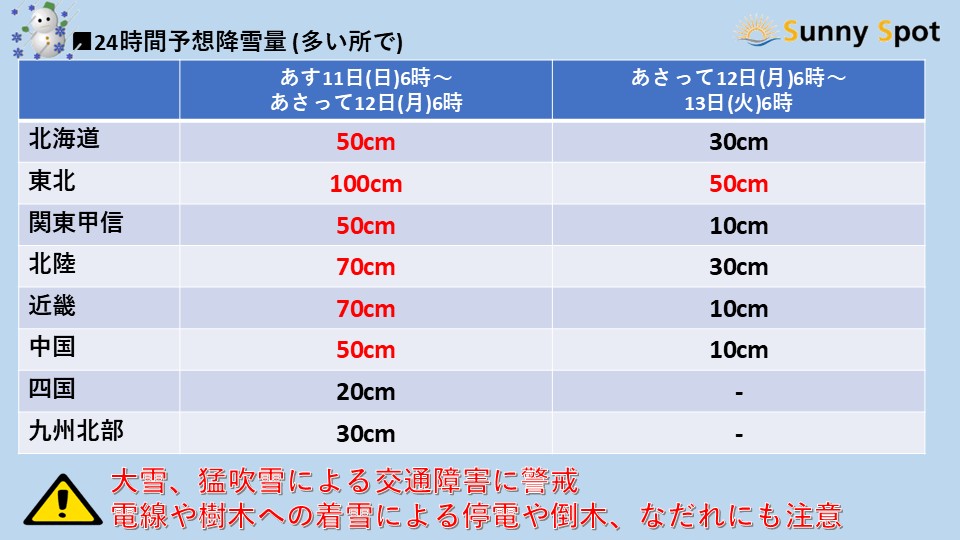
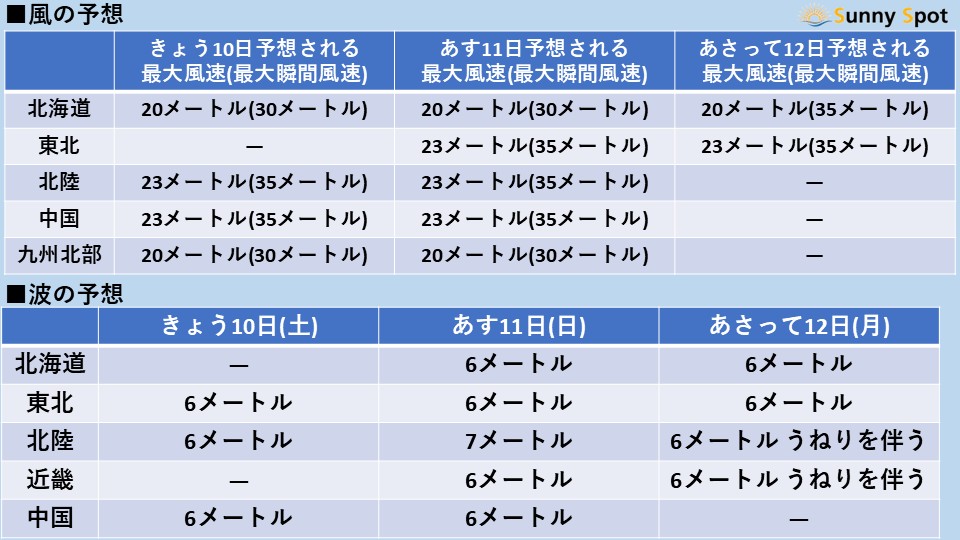
-
On the third day of the New Year, the winter-like atmospheric pressure pattern strengthens and the seas near Japan become widespread [Ocean Summary (December 28, 2025 to January 3, 2026)]
2026/01/09 16:25

-
On the third day of the New Year, the winter-like atmospheric pressure pattern strengthened near Japan, and the winds became stronger and stormy in some places.
The sea near Japan became a barge.
Below is the ocean summary (December 28, 2025 - January 3, 2026)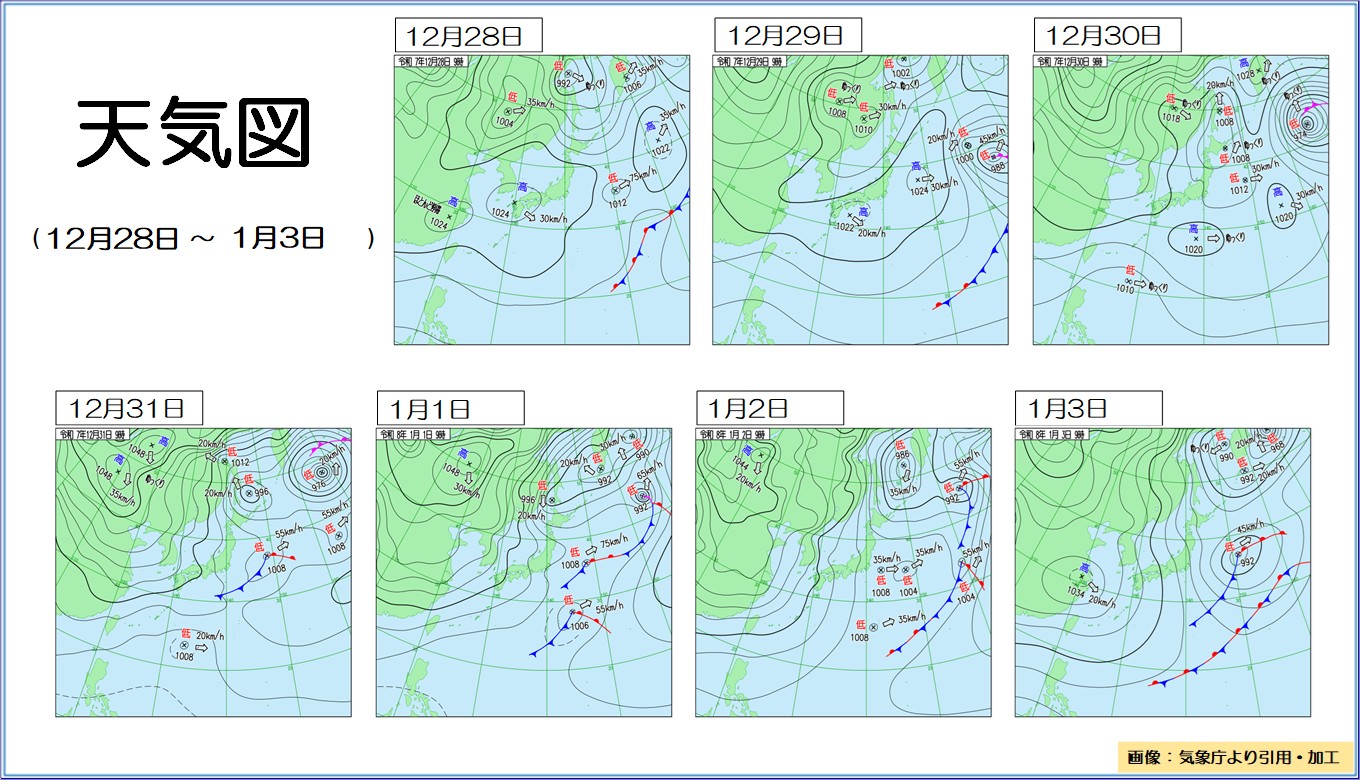
#Pressure distribution and waves
On the 28th, a high pressure system moved near Japan.
A low-pressure system moved over northeastern China, and the gradient in pressure between the high and low pressure systems became large.
Waves increased in the northern Sea of Japan, Sea of Okhotsk, and east of Japan.
From the 30th to the 31st, a low pressure system moved eastward south of Japan.
Also, another low pressure system moved eastward east of Japan, and a continental high pressure system extended to the south of Japan, gradually creating a winter-like pressure pattern around Japan.
The waves gradually increased in the waters near the Nansei Islands, the Sea of Japan, and the east of Japan.
From the 1st to the 3rd, there was a strong winter-like atmospheric pressure pattern near Japan, with barges occurring in the East China Sea, on the 1st off the coast of Akita, on the 2nd near the Nansei Islands, off the coast of the San'in area, and in the Sea of Okhotsk, and on the 3rd in the south and east of Japan.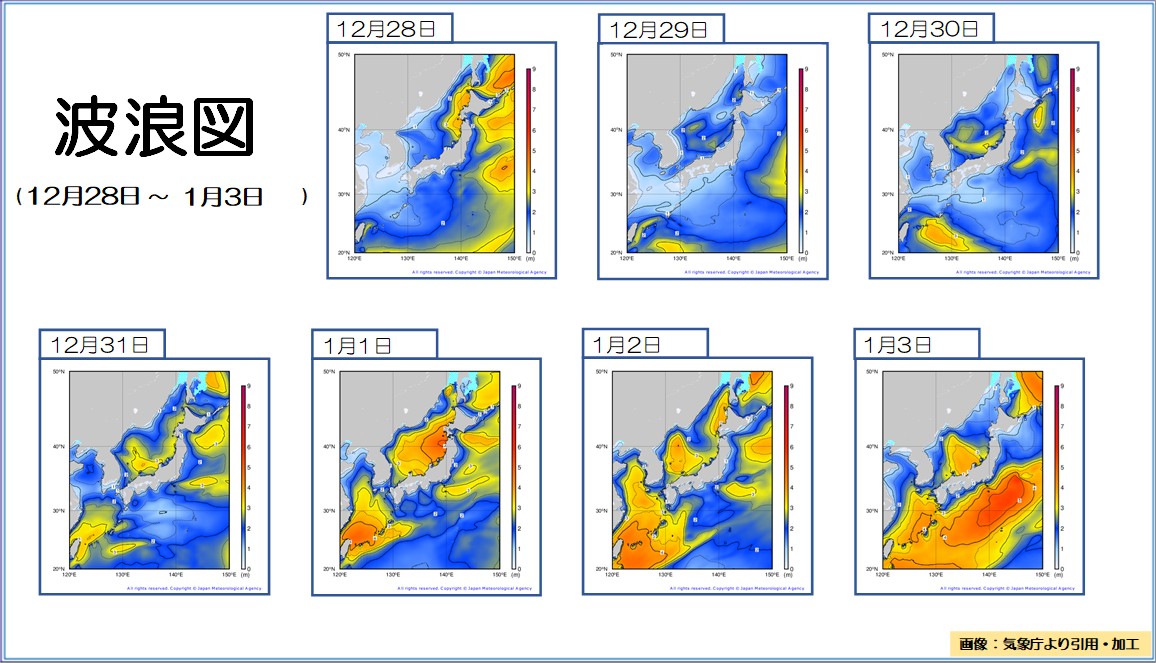
#Sea surface temperature
Sea surface temperatures in the Japanese sea area were higher than normal or significantly higher than normal, with areas expanding, and the sea surface temperature was up to 4 C higher than normal.
In the East China Sea, areas slightly higher than normal have expanded.
South of Japan, the sea area continues to be at normal levels, and off the coast of the Tokai region, the area below normal levels has shrunk.
Off the coast of Sanriku, sea conditions continued to be higher than normal in the north and lower than normal in the south.
Continuing, the sea off the southeastern coast of Hokkaido and around the Kuril Islands remained at or below normal, and the Sea of Okhotsk remained at normal.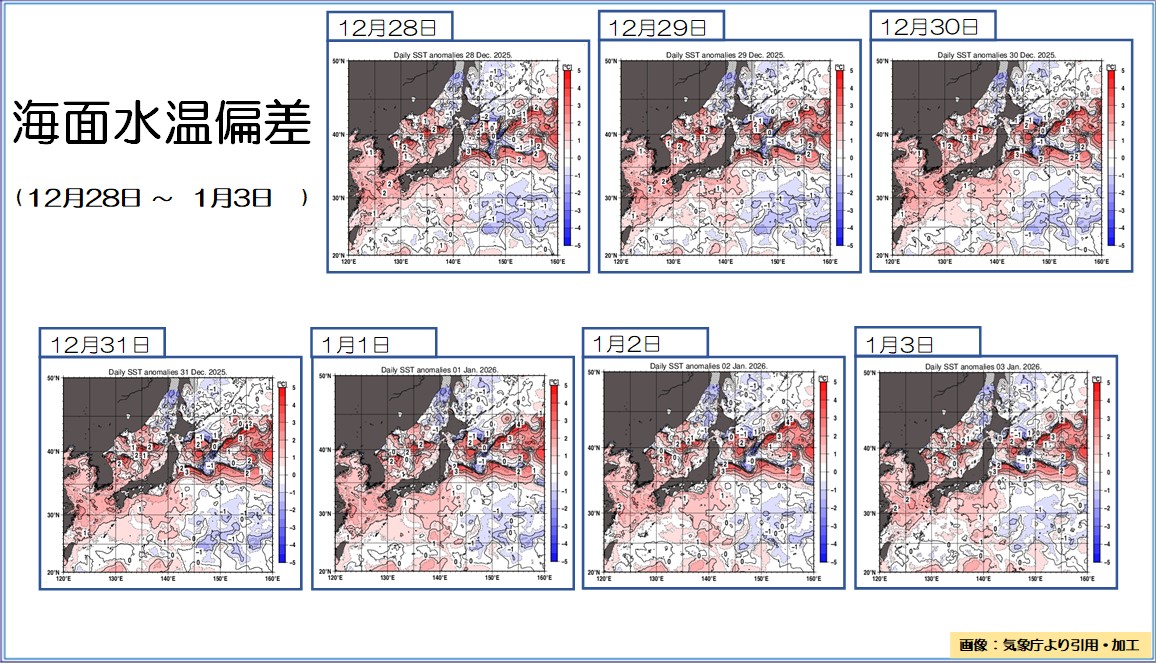
-
[Latest] 3-day winter storm, 100cm of snowfall in one day, the coldest air of the season hits towards Coming of Age Day
2026/01/09 12:31
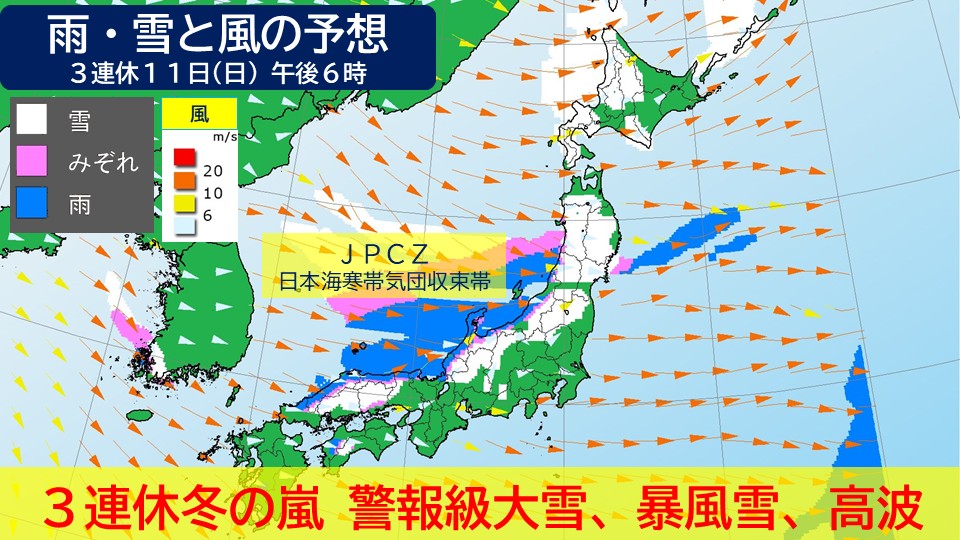
-
#3-day winter storm The coldest air of the season, warning heavy snow, blizzard, high waves
#Maximum instantaneous wind speed 35m/s, wave height 7m Snowfall amount in 24 hours 100cm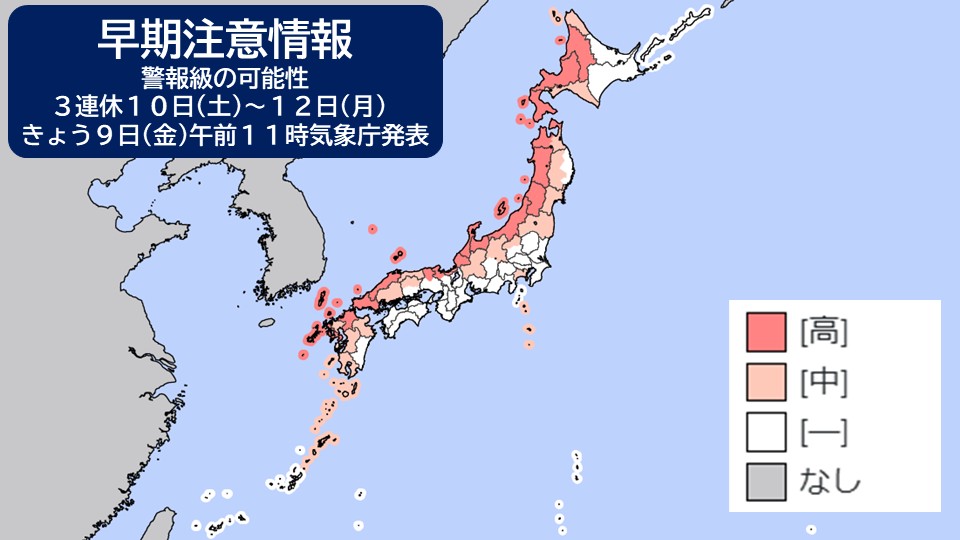
#3-day holiday winter storm The coldest air of the season. Heavy snowfall, blizzard, high waves
Tomorrow, the 10th (Saturday), the first day of the 3-day holiday, a large-scale cold vortex with -48c air will form from northeast China to Siberia at an altitude of around 5500 meters.
Around Japan, a low-pressure system is expected to rapidly develop along with a front as it moves across the Sea of Japan, resulting in a winter-like pressure pattern once again.
Winds will become stronger and waves will rise over a wide area, and a strong cold air will begin to flow across western and northern Japan at night.
The next day, on the 11th (Sunday), the low pressure system in the Sea of Japan will continue to develop and move towards the Sakhalin area, and the winter-like pressure pattern is expected to become stronger.
Also, by morning, the JPCZ (Japan Sea Polar Air Mass Convergence Zone) will be formed, heading towards Hokuriku, and then slowly moving south.
The snow is expected to become heavier in the JPCZ area, resulting in heavy snow in some places.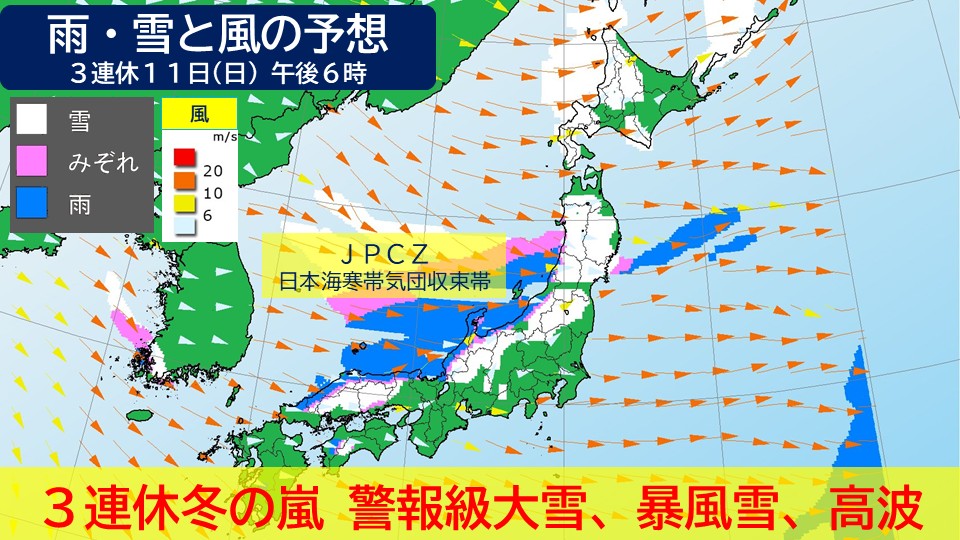
Then, on the 12th (Monday), Coming of Age Day, the strongest cold air of the season will flow into Japan.
Northern Japan is expected to be covered in cold air at around 5,500m above the ground, with temperatures below -42c, around 10c lower than normal.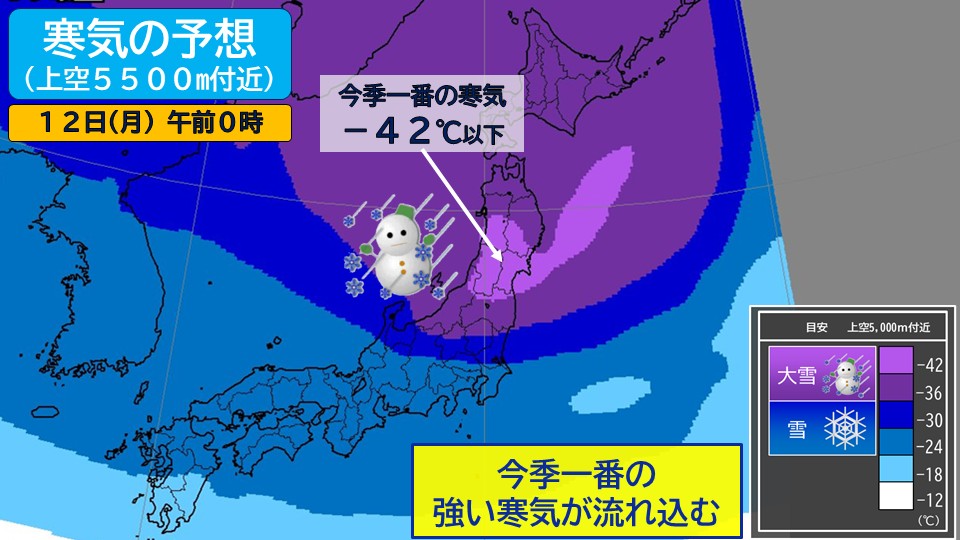
In addition, cold air with temperatures below -12c at an altitude of around 1500m will move south to the vicinity of China, where there was a strong shaking the other day.
It is nearly 10 degrees Celsius lower than normal, and this is also the strongest cold air flowing into western Japan this season.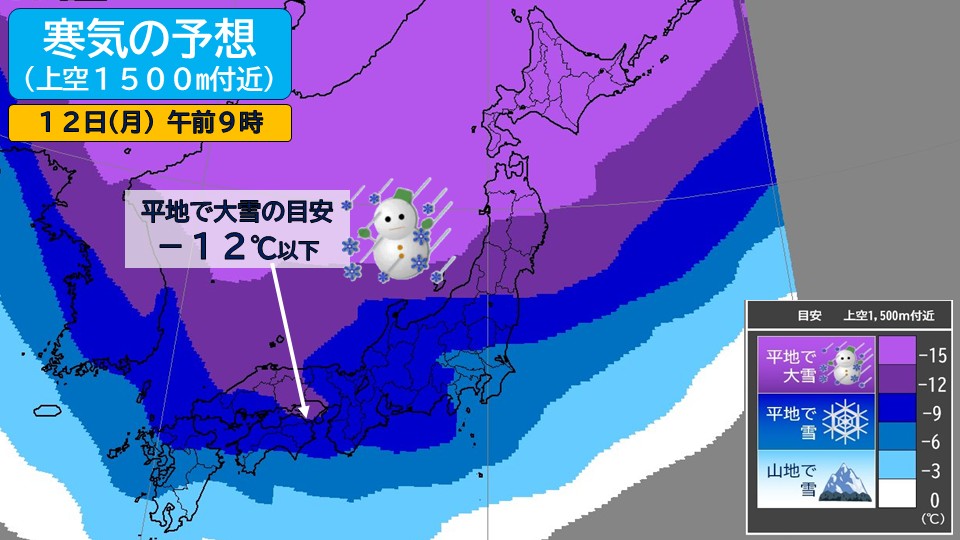
From yesterday, the 8th (Thursday), even stronger cold air will flow in, and there is a risk of severe weather over a wider area.
There is a high possibility of warning-level heavy snow, blizzards, and high waves mainly in the Sea of Japan side of western and eastern Japan and in northern Japan.
#Maximum instantaneous wind speed 35m/s, wave height 7m, snowfall 100cm
in 24 hours Tomorrow, the 10th (Saturday), the maximum instantaneous wind speed is expected to be 35m/s on the sea in the San'in region and the Hokuriku region, and 30 m/s on the Tsushima Strait, on land in the San'in region, on the sea in the Kinki region, and on land in the Hokuriku region.
The expected wave height is 6m in Chugoku and Hokuriku, and 5m in Kinki and northern Japan.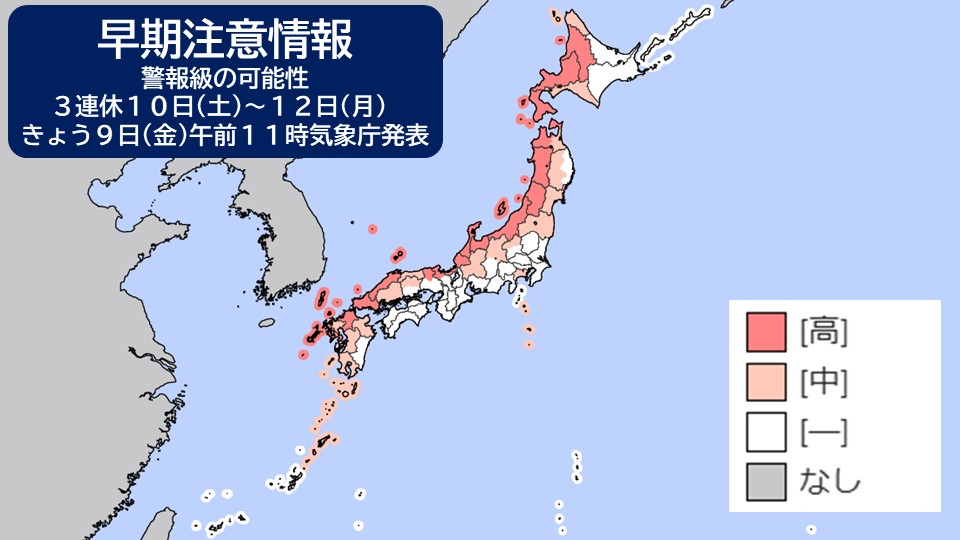
There is a risk of warning-level snowstorms in northern Kyushu, San'in, Nagano Prefecture, Hokuriku, and northern Japan, and warning-level high waves from San'in to the Sea of Japan side of northeastern Japan.
The day after tomorrow, the 11th (Sunday), maximum instantaneous wind speeds of 35 m/s are expected in the San'in area, Hokuriku, the sea off the Sea of Japan side of northeastern Japan, and on land in the southern part of Hokkaido on the Sea of Japan side.
Stormy winds with maximum instantaneous wind speeds of 30 m/s will also rage on land in the San'in region, Hokuriku region, and the Sea of Japan side of northeastern Japan.
Wave height is expected to be 7m in Hokuriku, 6m in Chugoku, Kinki, and northern Japan, and 5m in northern Kyushu and Kanto-Koshin.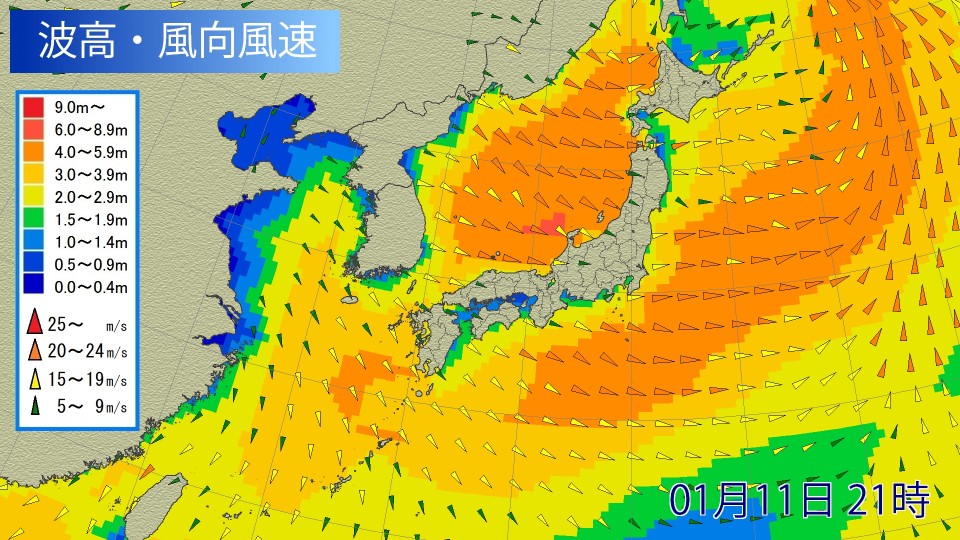
There is a risk of warning-level heavy snowfall in Chugoku, northern Kinki, Gifu Prefecture, northern Nagano Prefecture, northern Gunma Prefecture, Hokuriku and northern Japan, warning-level snowstorms in Kyushu, San'in, Hokuriku and northern Japan, and warning-level high waves in Nansei Islands, Kyushu, San'in - Hokkaido Sea of Japan side, and Kanagawa Prefecture.
The next day, on the 11th (Sunday) and 12th (Monday), there is a risk of warning-level heavy snowfall in China, northern Kinki, Gifu prefecture, northern Nagano prefecture, northern Gunma prefecture, Hokuriku and northern Japan, warning-level blizzard on the Sea of Japan side north of Hokuriku, and warning-level high waves from San'in to the Sea of Japan side of Hokkaido.
The amount of snowfall in the 24-hour period from the morning of the 11th (Sunday) to the morning of the 12th (Monday) was heavy in some places, reaching 100cm in Tohoku.
Please keep an eye on the latest information as it may affect transportation over the three-day weekend.
-
It will be very rough on the Sea of ??Japan side during the 3-day weekend, so be careful of heavy snow and strong winds.
2026/01/09 08:31
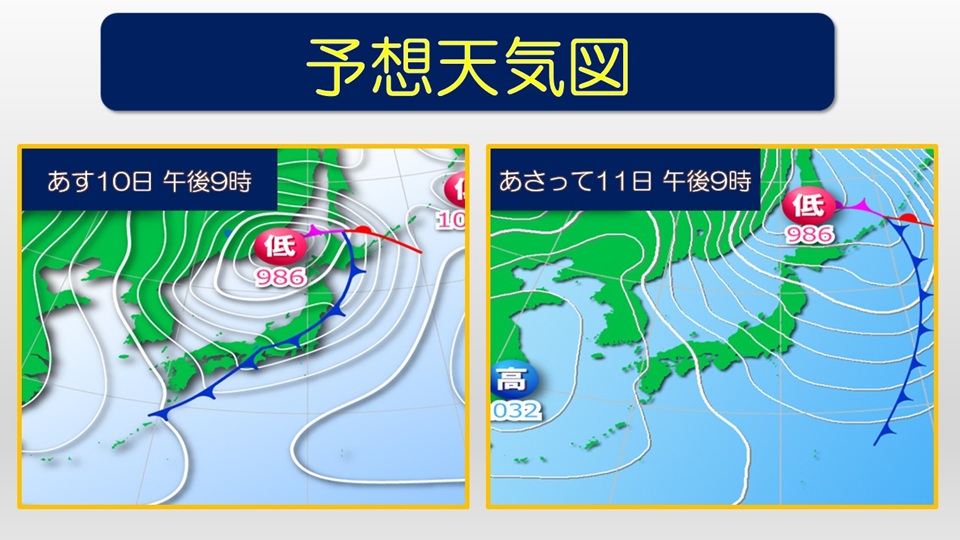
-
On Saturday the 10th, the first day of the three-day weekend, a low pressure system near the Korean Peninsula is expected to rapidly develop and move toward the northern Sea of Japan.
After that, from the 11th (Sunday) to the 12th (Monday) the day after, there will be a strong winter-like atmospheric pressure pattern near Japan, and strong cold air will flow into the sky above Japan.
As a result, it is expected that there will be severe storms and severe storms across a wide area from northern to western Japan from tomorrow the 10th (Saturday) to the 12th (Monday). Vigilance will be required in northern Japan due to strong winds, blizzards, high waves, and traffic disruptions caused by heavy snow.
Today, the 9th, on the Sea of Japan side, the weather is likely to have many pauses during the day. It is safe to proceed with snow removal work today.

[Wind Forecast]
Extremely strong winds will blow from northern Japan to western Japan, causing strong winds and heavy snow in some places.
#Expected wind strength
+Maximum wind speed (maximum instantaneous wind speed) expected for tomorrow the 10th (Saturday)
Hokuriku region 23 meters (35 meters)
Kinki region 20 meters (30 meters)
Chugoku region 23 meters (35 meters)
Northern Kyushu 20 meters (30 meters)
+Maximum wind speed (maximum instantaneous wind speed) expected for the 11th (Sunday) tomorrow Hokkaido 20 meters (35 meters)
East Northern region 23 meters (35 meters)
Kanto-Koshin region 20 meters (30 meters)
Hokuriku region 23 meters (35 meters)
Kinki region 20 meters (30 meters) )
Chugoku region 23 meters (35 meters)
Northern Kyushu region 20 meters (30 meters)
After that, extremely strong winds are expected to continue until around the 12th (Monday), resulting in strong winds and heavy snow in some places.
[Wave Forecast]
There will be some places on the Sea of Japan side from northern Japan to western Japan that will be rocky.
#Expected wave height
+Expected wave height for tomorrow 10th (Saturday)
Hokkaido region 5m
Tohoku region 5m
Hokuriku region 6m
Kinki region 5m
Chugoku region 6m
+Expected wave height on the 11th (Sunday)
Hokkaido region 6m
Tohoku region 6m
Kanto-Koshin region 5m
Hokuriku region 7m
Kinki region 6m
Chugoku region 6m
Northern Kyushu region 5m
After that, there are expected to be some places where there will be heavy rain until around the 12th (Monday).
[Snow Forecast]
There will be heavy snowfall in some places, mainly from northern Japan to western Japan on the Sea of Japan side.
#Forecasted amount of snow (in places with a lot of snow)
+24-hour snowfall expected by dawn on the 12th (Monday)
North Kaido region 50cm
Tohoku region 100cm
Kanto-Koshin region 50cm
Hokuriku region 70cm
Tokai region 70cm
Kinki region 70cm
Chugoku region 50c m
Shikoku region 20cm
After that, there will be more snowfall in some places until around the 12th (Monday).
I'm sure many of you are planning to go out for the three-day weekend, but transportation may be affected, so please pay close attention to the latest weather and traffic information, and consider revising your plans.
-
Today's weather on the 9th (Friday) Weather will improve during the day on the Sea of ??Japan side; many places from eastern to western Japan will be sunny
2026/01/09 06:24
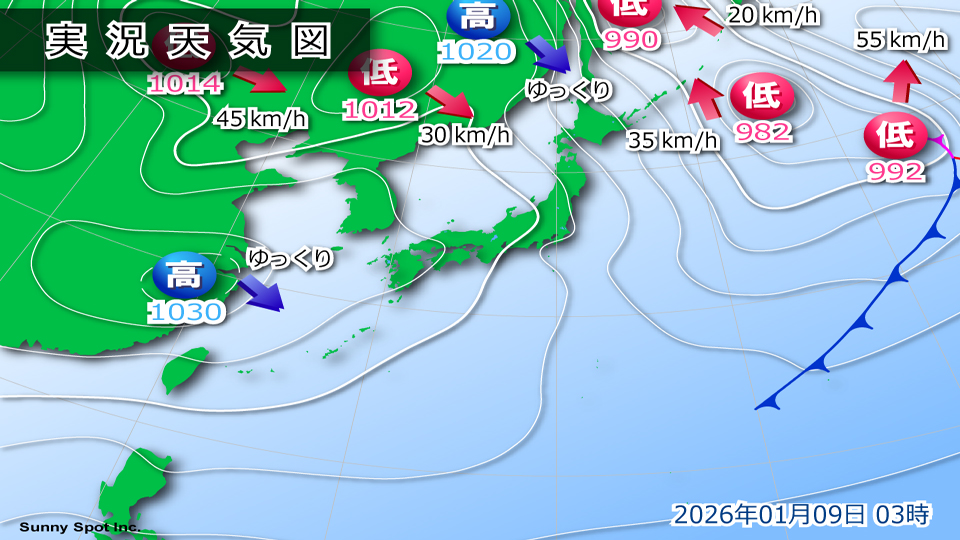
-
Today, the 9th (Friday), a high pressure system will emerge from the west, and the winter-like pressure pattern will start to dissipate. It is expected to stop in many places along the Sea of Japan side. It looks like it will be sunny in many places on the Pacific side.

On the Sea of Japan side of Hokkaido and the Hokuriku region, there will be snow and rain until the morning, but it is expected to stop in many places by the afternoon. However, there are places on the Sea of Japan side of northern Japan where it will start snowing and rain again from night, so you need to be careful about deteriorating road conditions and snow falling from roofs.
Although there are periods of sunshine on the Pacific side of northern Japan, there is a possibility of snow showers, so please be careful of changes in the sky.
It will be sunny throughout the winter from the Pacific side of eastern Japan to western Japan.
It will be bitterly cold during the day, with the highest temperature expected to be around 10c in many places. Please take proper measures to protect yourself from the cold before going out.
The sky in Okinawa will be dominated by clouds. The air seems to be cool with only occasional sunshine. It will be safe to have a folding umbrella when going out.
-
Weather and temperature summary (December 28th to January 3rd): Strong cold air moving south; first snow observed in Tokyo; coldest of the season
2026/01/08 18:29
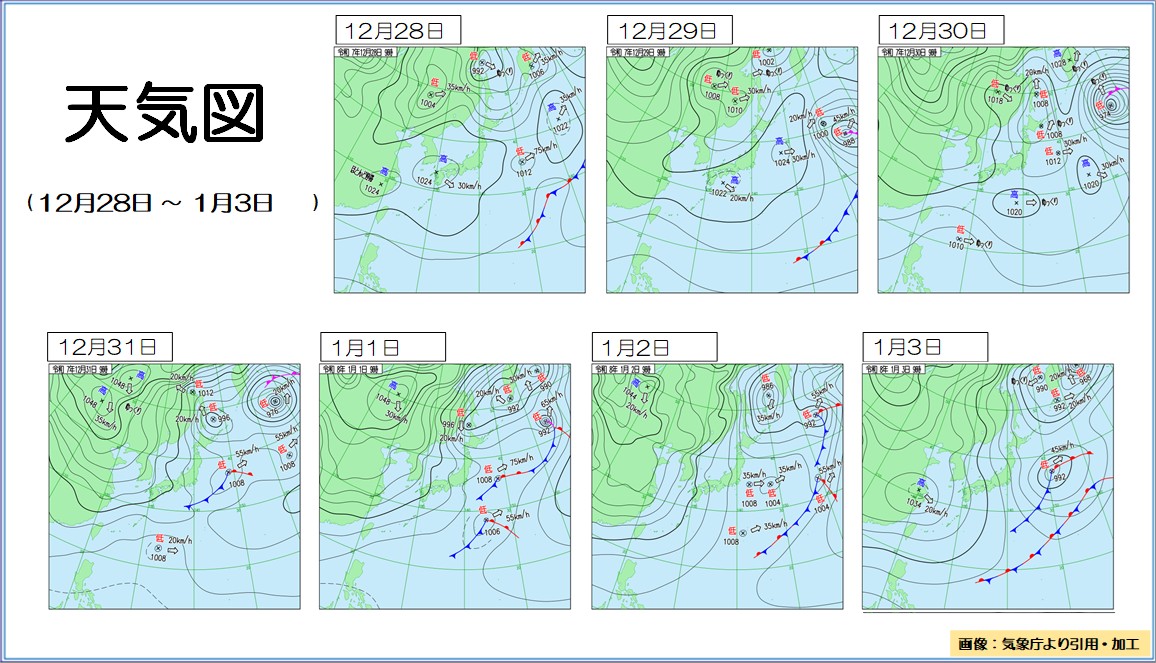
-
This is a summary of the weather and temperature from December 28, 2025 to January 3, 2026.
[About this period's weather]
#Characteristics of atmospheric pressure distribution
On the 28th, the area around Honshu was widely covered by a mobile anticyclone. There was a trough in the atmospheric pressure near northern Japan, and the spacing between isobars became narrower. On the 29th, the center of high pressure moved eastward to the east of Japan and south of Honshu. A low pressure system is moving north-northeast over the northern Sea of Japan. On the 30th, a low pressure system moved northward over the Sea of Okhotsk. At 9:00 a.m., a low pressure system also formed in the waters near the Kuril Islands, east of Japan, and south of the Nansei Islands. The center of a mobile anticyclone moves eastward south of Japan. On the 31st, a low pressure system accompanied by a front moved eastward east of Japan. A low pressure system in the Sea of Okhotsk is moving north-northwest. A winter-like pressure pattern is formed near Honshu. The low pressure system south of Honshu moves eastward and gradually approaches the Ogasawara Islands. On the 1st, a low pressure system moved south near the Mamiya Strait. Winter-type atmospheric pressure is present near Japan. On the 2nd, a series of low pressure systems formed in the eastern Kanto region. Both heading northeast. Winter-like atmospheric pressure patterns continue near Japan. On the 3rd, a low pressure system accompanied by a front moved northeast east of Japan. Near Honshu, the winter-like atmospheric pressure pattern continues to be high in the west and low in the east. A cold front extending from a low pressure system passes through the Ogasawara Islands.
#Precipitation
In the early hours of the 28th, the snow became heavier in Hokkaido, and in Urakawa, the snowfall in 3 hours was 18cm, breaking the highest value for December. It rained intermittently in the Nansei Islands. On the 29th, the Shear Line approached from the Sea of Japan. Rain fell on the Sea of Japan side of northern Japan and Hokuriku. Heavy rain fell in the Nansei Islands due to the influence of moist air circulating around the edge of a high-pressure system. On the 30th, rain and snow began in the morning on the Sea of Japan side of northern Japan and Hokuriku. By the afternoon, colder air gradually moved in and the area of snow expanded. The snow was falling heavily, especially along the mountains. On the 31st, snow and rain fell from northern Japan to Hokuriku. A heavy snow warning has been announced for Akita and Yamagata prefectures. On the 1st, cold air in the upper atmosphere moved southward, and some places in the Tohoku region experienced record-breaking snowfall, with over 80 cm of snow falling in 24 hours in Hijiori, Yamagata Prefecture. On the 2nd, strong cold air flowed into the sky, causing snow mainly on the Sea of Japan side. From the evening onwards, snow clouds developed in the Kanto region, with 1cm of snow falling in Tokyo and 5cm as far as Saitama. On the 3rd, snow fell from the Japan Sea side of northern Japan to the Sanin area. There were places along the mountains in the Kanto-Koshin region where 20cm of snow fell in three hours. In the afternoon, it gradually stopped in many places.
#Temperature
The morning of the 28th was extremely cold due to the effects of radiation cooling, making it the coldest of the season in the Kanto region. On the 29th, warm air flowed in and temperatures rose above normal across the country. In particular, there were many places in northern Japan where the temperature was higher than normal, with Sapporo recording a temperature of 5.6 C, 4.9 C higher than normal. On the 30th, warm air flowed in, causing temperatures to rise mainly on the Pacific side of eastern and western Japan. The temperature in central Tokyo was 15.3c, which is similar to late November. On the 31st, temperatures dropped in many areas compared to the previous day due to the influence of cold air moving south. There were many locations in midwinter, mainly in northern Japan. On the 1st, cold air moved south, causing severe cold mainly in northern Japan. It was also bitterly cold across eastern and western Japan, with temperatures lower than normal in many places, especially along the Sea of Japan. On the 2nd, it was bitterly cold, mainly in western Japan. Snow has been falling in central Tokyo since night, and temperatures are dropping. Temperatures exceeded 10 C during the day, but fell below 1 C at night. On the morning of the 3rd, the effects of cold air in the upper atmosphere remained, and many locations had new lowest temperatures this season. The morning minimum temperature in central Tokyo was -0.5c, the highest this season.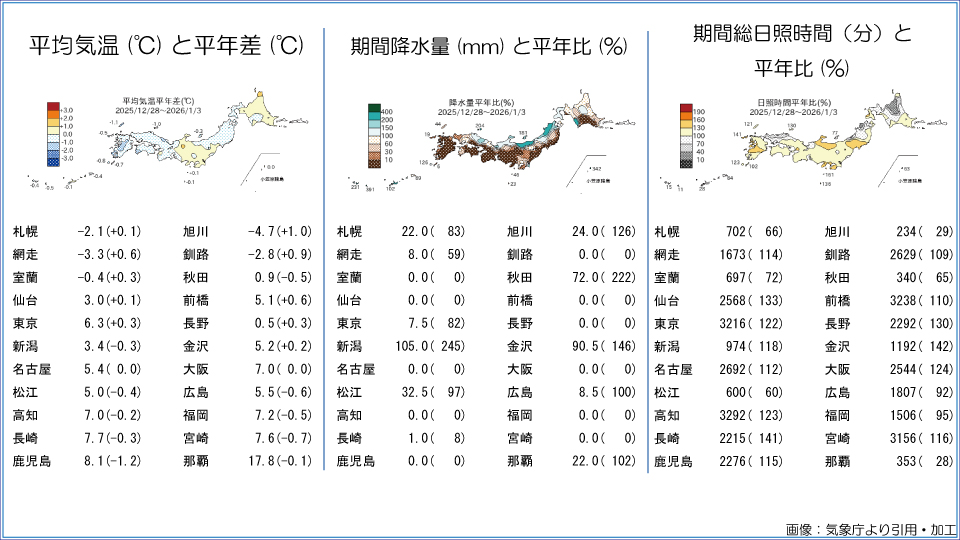
#Summary of the weather for this period (December 28th to January 3rd)
The average temperature was at or slightly lower than normal throughout the country, as cold air tends to flow in mainly during the latter half of the period. Central Tokyo has been experiencing a severe chill, with the first snowfall observed, and on the 3rd, the lowest temperature of the season was recorded at -0.5 C.
Precipitation was higher than normal on many days, mainly in the latter half of the period, with winter-like pressure patterns, and from the Sea of Japan side of northern Japan to the San'in area. On the other hand, from northern Japan to western Japan, precipitation was significantly lower than normal, mainly on the Pacific side, with many locations experiencing zero precipitation.
Sunshine hours were mostly sunny from eastern to western Japan, and in many places they were at or slightly above normal. The Japan Sea side of northern and western Japan had many days of snow and rain, and many places had less snow than normal.
-
[3-day winter storm] A large-scale cold vortex over mainland China; the coldest air of the season hits until Coming of Age Day
2026/01/08 12:58
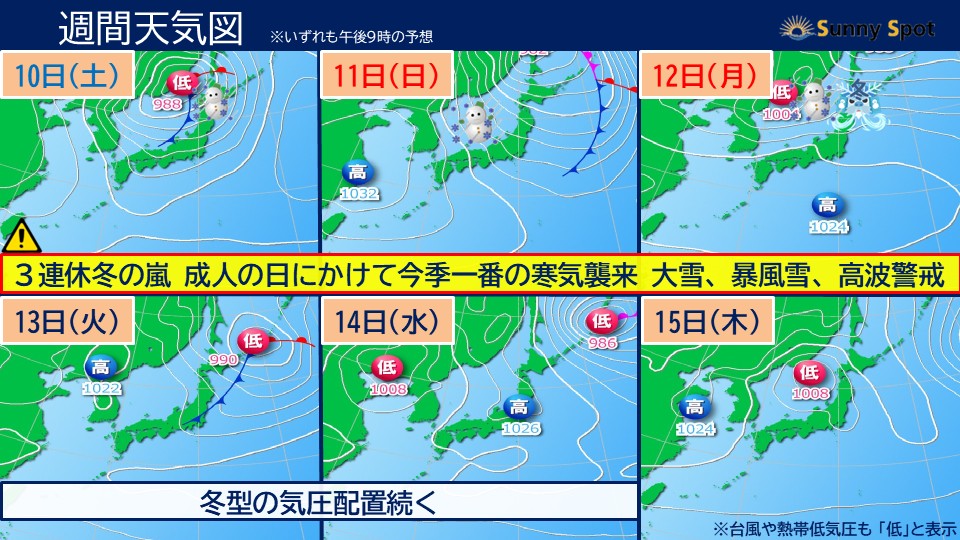
-
# Today's strong winter pressure distribution Maximum wind speed 21.7 m/s
at Cape Soya # 3-day winter storm Large-scale cold vortex over mainland China Coldest air of the season
# 3-day holiday Beware of warning-level heavy snow, blizzard, and high waves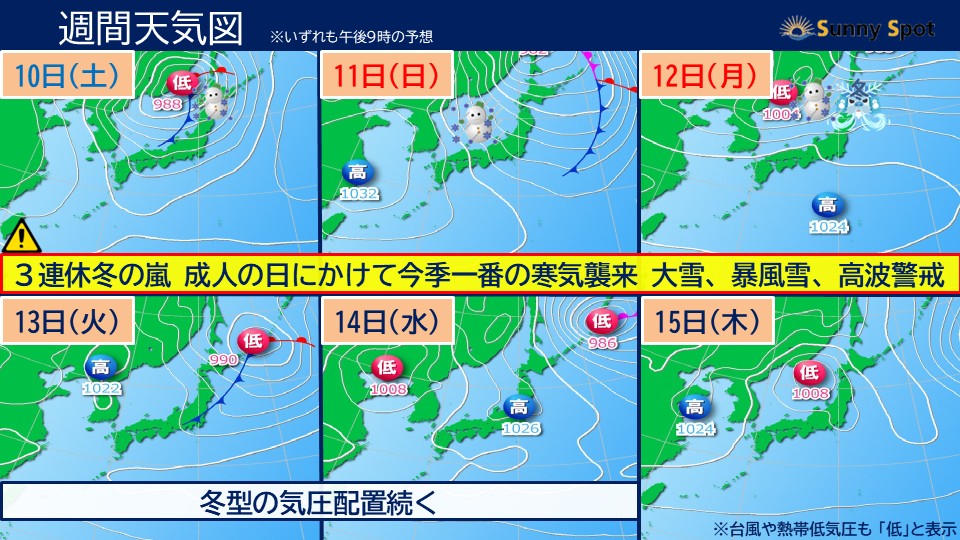
#Today's strong winter-type pressure pattern Maximum wind speed at Cape Soya 21.7m/s
Today, the 8th (Thursday), the winter-type pressure pattern is strengthening near Japan. Strong cold air is flowing into the sky, causing rough weather mainly on the Sea of Japan side.
Cold air below -42c is passing near 5500m above northern Hokkaido.
At Cape Soya, Wakkanai City, a maximum wind speed of 21.7 m/s was observed at 8:51 am.
As of noon, a heavy snow warning has been issued for the Ishikari region of Hokkaido.
Please be on guard for heavy snow tonight.
The blizzard warning and wave warning for northern Soya and Rishiri/Rebun have been lifted, but please continue to be careful of traffic disruptions due to snowdrifts and snowdrifts, strong winds, and high waves until tomorrow, the 9th (Friday).
The expected maximum instantaneous wind speed is 30 m/s even on land, and the wave height is 5 m.
The winter-like atmospheric pressure pattern will gradually loosen up until tomorrow, the 9th (Friday).
However, over the three-day weekend, winter-like atmospheric pressure patterns are expected to strengthen again, creating a winter storm centered on the Sea of Japan side.
From today, the 8th (Thursday), even stronger cold air will flow in, and there is a risk of severe weather over a wider area, increasing the possibility of warning-level heavy snow, blizzard, and high waves.
#3-day winter storm A large-scale cold vortex over mainland China The coldest air of the season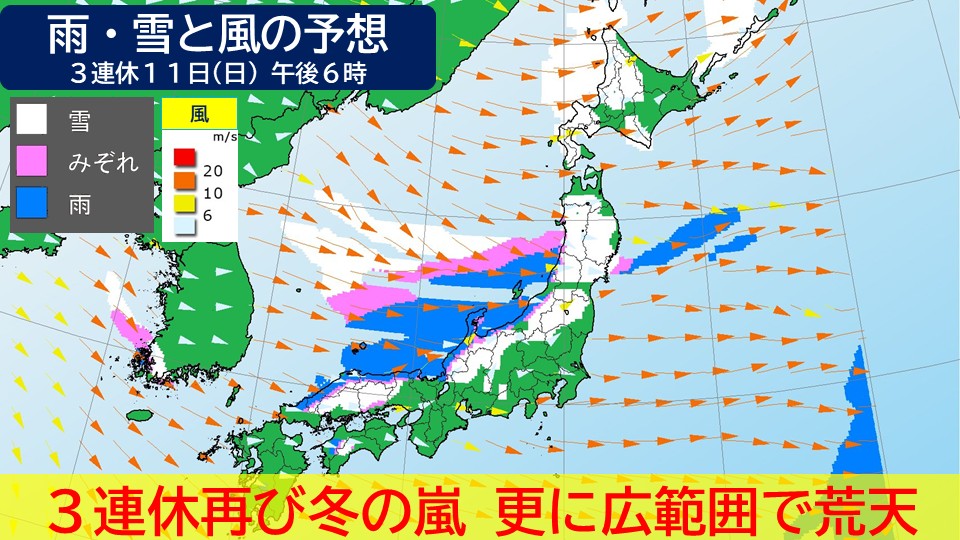
On the 10th (Saturday), the first day of the three-day holiday, a large-scale cold vortex with temperatures as low as -48c will form from northeastern China to Siberia at an altitude of around 5,500m.
Around Japan, a low pressure system is expected to rapidly develop as it moves through the Sea of Japan, resulting in a winter-like atmospheric pressure pattern once again.
Winds will become stronger and waves will rise over a wide area, and a strong cold air will begin to flow across western and northern Japan at night.
Towards the 11th (Sunday), the low pressure system in the Sea of Japan will continue to develop and move toward the vicinity of Sakhalin.Then, strong cold air will flow into the vicinity of Japan until the 12th (Monday), coming of age, creating a strong winter-like pressure pattern.
On the 12th (Monday), Coming of Age Day, northern Japan will be completely covered in cold air with temperatures below -42c at an altitude of around 5500m.
This is about 10 degrees Celsius lower than normal, and is the strongest cold air flowing into northern Japan this season.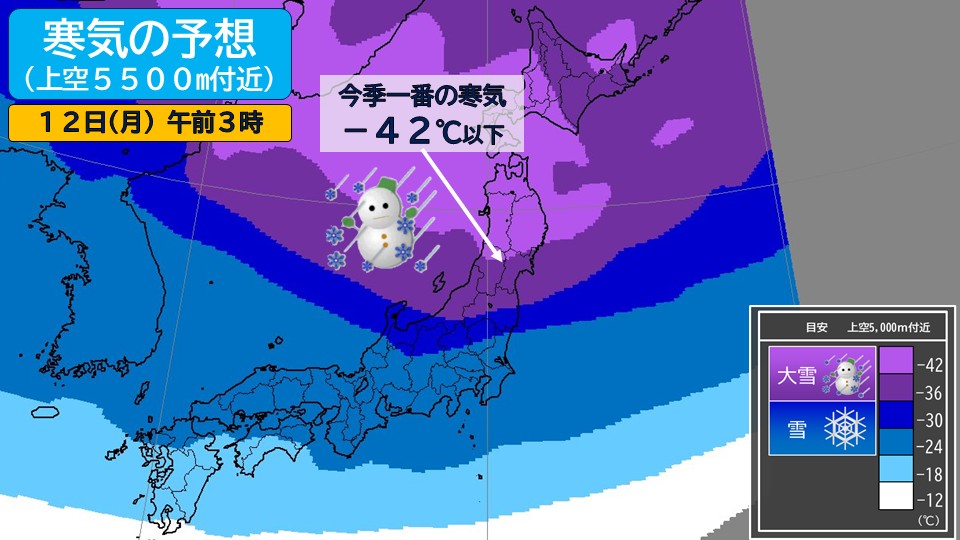
In addition, cold air with temperatures below -12c at an altitude of around 1500 meters will move south to the vicinity of China, where there was a strong shaking the other day.
It is nearly 10 degrees Celsius lower than normal, and this is also the strongest cold air flowing into western Japan this season.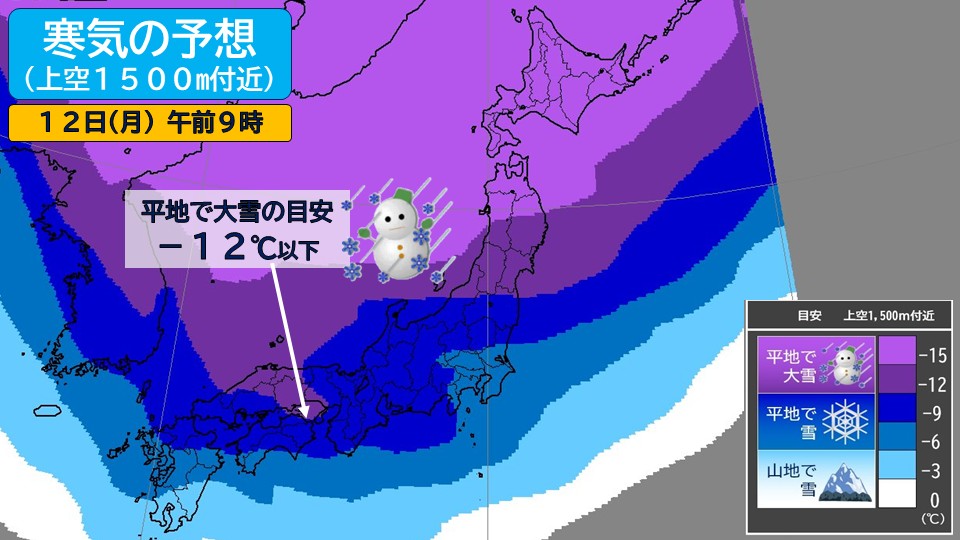
From today, the 8th (Thursday), even stronger cold air will flow in and there is a risk of severe weather over a wider area.
There will be heavy storms, heavy snowfall, and warning level heavy snow in some places along the Sea of Japan side of western and eastern Japan and in northern Japan.
#3-day holiday Warning-level heavy snow, blizzard, and high waves / 10th (Saturday), warning-level blizzard in northern Kyushu, San'in, Nagano Prefecture, Hokuriku, and northern Japan; warning-level high waves in San'in and northeast Japan Sea side; 11th (Sun) warning-level blizzard in western and northern Japan Sea of Japan sides On the 11th (Sunday) and 12th (Monday), there is a risk of warning-level heavy snowfall in the Sea of Japan side of China to Hokkaido, Gifu prefecture, northern Nagano prefecture, and northern Gunma prefecture, warning-level snow storms on the Sea of Japan side north of Hokuriku, and warning-level high waves in the Sea of Japan side of western and northern Japan.
Please be aware of the latest information as the three-day holiday may affect transportation.
Then, winter-like atmospheric pressure patterns are expected to continue into the 14th (Wednesday).







